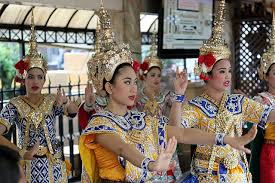Thai dance (Ram thai) is characterized by slow, almost hypnotic graceful hand movements. Historically, Thai dance is closely intertwined with stage and is thus expressive and theatrical. Thai dance is choreographed with beautiful and soft music focused on the visual aspect of the viewer. Men and women are dancing in groups, alone or together. The emphasis is not on the flirtation between men and women, as in many Western dance.
The graceful poses and movements are a feast for the eyes. They have a clear meaning like sadness, love, embarrassment, anger or tribute to the king of Buddha. There are also sword and harvest dances.
 Basically Thai dance is based on slow rhythms, even though some Thai folk dances go pretty fast. The slow rhythm requires good balance and controlled posture.
Basically Thai dance is based on slow rhythms, even though some Thai folk dances go pretty fast. The slow rhythm requires good balance and controlled posture.
The highlight of Thai classical dramatic art is undoubtedly "Khon", the masked Thai dance that already since the 14th century, is staged at the Thai court.
The khon dance gives artfully expresses to an imaginary world of angels, humans, demons, gods, and the monkey army of Hanoman. He is silently executed.
The dancers wear beautiful dragon costumes and beautiful masks made of paper mache. Each stylish movement has its own meaning.
The dancers show characters from an ancient literary tradition. Usually they carry on the Ramayana.
The Ramayana is called in Thailand Ramakien. It is an epic poem of 50,086 verses. It was between the third century BC and the third century AD written in Sanskrit, the ancient classical Indian language.
The dances are accompanied by an orchestra of drums, bells, flutes and xylophones.
Thai dances range from traditional (khon) to modern (likay). Modern dance form is more like Western drama, with a combination of song, dance and cabaret. In the south of the country they have adapted the Thai art of shadow play from the Indonesians.
In Thai dancing much more than Western dance , is the movement of the arms and hands important. The elegance to a great extent is defined by the hands and arms. Thai dancers seem to bend their fingers back sometimes almost at a right angle.
It appears to be the habit for centuries that many mothers, when they bathe their daughters stretch their fingers several times as far as back as possible. The stretched tendons in that way would be the secret behind this Thai dance.
